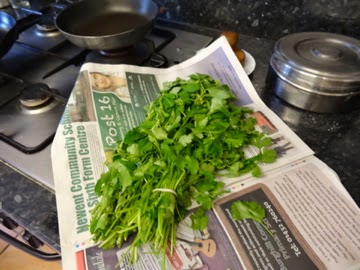1) ヘンナ/ Henna (Medihi)
A. Sの手 / S' Hands
2013年9月3日に、カーディフのRの友人S宅を訪問。
その晩は、Sの手料理をごちそうになり、彼女の家に泊まりました。
Sは料理はあまり、得意でないと言いますが、そんなことはないと私には思えます。
彼女は、実業家であり、また、彼女の妹さんやお母様がお料理が得意なので、
彼女にそう思わせるのでしょう。
Sが料理を作り始める前に、気がついたのは彼女の手に以前は見られなかった模様があったことです。
最初は入れ墨?と思ったのですが、単に一時的にペイントされたもので、
ヘンナ / Henna (Medihi)と呼ばれる、インドの伝統的な手足にほどこされる
ボディペインティングでした。
特に、結婚式などでは良く見られるようです。
最近、彼女は家族の結婚式に参加しました。
そのときのヘンナ がまだ残っていたのです。
 |
| ヘンナ / Henna (Medihi) 「ヘンナ」は植物名でもあり、ペインティングの名称としても使用されます。 下記はWikipediaより抜粋 和名は、指甲花(シコウカ)・ツマクレナイノキ・エジプトイボタノキ。 葉を乾燥させ粉にしたものを水などで溶いたものが、古くから髪・眉・爪・手足などの染色やペイントに使用されている。染料となるのはローソンという赤色(オレンジ色)色素で、そのローソンがタンパク質に絡み付く習性を持っているために、人間の頭髪や皮膚に色が付く。その歴史は、記録に残っている限りでは先史時代にまで遡り、クレオパトラもヘンナで爪などを染めて、現代で言うマニキュア代わりとして使用していたという。 |
S' Hands
On the day, S cooked our dinner and we stayed in her house.
She said she is not good at cooking, although I do not think so.
I think she is a businesswoman and her mother and sister are very good at cooking which makes her thought like that.
Before she cooked I found patterns on her hands which were not there the last time we visited her.
Firstly I thought they were tattoos, however, they were just temporary painting which is called Henna (Medihi).
The plant name gives its name to this traditional Indian style of painting on hands and feet.
The plant name gives its name to this traditional Indian style of painting on hands and feet.
It is especially common for Indian weddings.
Recently S had been to a family wedding, so that wedding painting was still on her hands.
B. 由来 / The Origin
ヘンナ/ Medihi は、サンスクリッド語の"mendhikā"から由来し、早期の『ヴェーダ / Vedas』にも説明があるとWikipedia (英語版:Medihi)にはあります。
ヘンナ/ Medihi は、サンスクリッド語の"mendhikā"から由来し、早期の『ヴェーダ / Vedas』にも説明があるとWikipedia (英語版:Medihi)にはあります。
下記はWikipedia(日本語版:ヴェーダ)より
”ヴェーダ(梵: वेद 、Veda)とは、紀元前1000年頃から紀元前500年頃にかけてインドで編纂された一連の宗教文書の総称。「ヴェーダ」とは、元々「知識」の意である。”
2)インド料理/ Indian Cooking
3)部屋 / Rooms
ヴェーダの"mendhikā"は、"内部の太陽(神)の象徴"であり、ペインティングの慣習は、"内なる光を呼び覚ます"目的で行われます。
ですが、ヘンナのペインティングは、インドだけでなく、アラビアの世界にもありますので、由来も意味も様々です。
紀元前から現在までの間に、人々は様々な解釈を加えてきたのでしょう。
そしてまた、ボディペインティングは、多くの違った文化に共通しているものだと感じます。
伝統的な柄やデザインには呪術的なものが含まれているのだな〜とつくづく思います。
The Origin
[~ It is also derived from the Sanskrit word mendhikā.
According to Wikipedia about Vedas
[The Vedas are among the oldest sacred texts. The Samhitas date to roughly 1700–1100 BCE,[21] and the "circum-Vedic" texts, as well as the redaction of the Samhitas, date to c. 1000-500 BCE, resulting in a Vedic period, spanning the mid 2nd to mid 1st millennium BCE, or the Late Bronze Age and the Iron Age.
The Sanskrit word véda "knowledge, wisdom" ]
They say "mendhikā" is a symbol of the sun (sun's god) and the custom of the painting has a "awakening the inner light."
However, the customs of the painting are from the Indian and Arabic worlds, so the origin and the meaning are many.
I think from B.C. to now, people have added many interpretations.
My feeling is that body painting is common with many different cultures.
Again traditional patterns and designs are related to the supernatural I guess.
2)インド料理/ Indian Cooking
 |
| たくさんの量の香辛料、食材、スナック類 Many spices, ingredients and snacks |
 |
| 小分けの香辛料 この入れ物には、ひとつの蓋がついています。 Seven Spices Tin (Lid not shown) |
 |
| 野菜カレー Sはベジタリアンです。 Vegetable Curry S is a vegetarian. |
チャパティ / Chapati
 |
| チャパテティ:★ クレープのようなパン、トルティーアに似ていると思います。 チャパティは小麦粉(全粒粉)から作られ、 トルティーアは主にともうもろこしですが、小麦粉もあるようです。 Sは瞬く間に生地を作ります。 上の写真の状態にしてから、めん棒でのばします。(下の写真) Chapati: ★ A type of bread like a pancake. I think it is similar to 'Tortilla'. 'Chapati' is made of whole wheat flour (or wheat flour), 'Tortilla' mainly made of corn, sometimes of wheat flour. S makes the dough so quickly. The dough is divided into small pieces : above photo, then it is rolled with a rolling pin: below photo. |
 |
| 生地をのばす早さも尋常ではなく、 カメラもその早さには追いつかない! 彼女は結婚式のとき、1000枚ほど作ったそうです。 Her rolling is unusually fast, my camera cannot catch it. She made about 1000 for the wedding. |
 |
| 焼く前のチャパティと道具 Chapati and tools before cooking |
 |
| 膨らんできたチャパティを上の写真の道具で とんとんたたいて、平に戻します。 Chapati rises then it is pressed down with a tool (above).  |
 |
バターがバケツサイズの容器に入っていてびっくり!
Butter is in a container the size of a bucket,
so I was very surprised.
溶かしバターをかけて、できあがり!
Put melting butter and then it is finished!
|
 |
| コリアンダー (香菜) 入りチャパティを作る 写真がぼけていてすみません... Making Chapati with coriander No focus, sorry....  刻んで生地に練り込みます。 あとは同じ! Chopped coriander mixed in the dough. Cooked as before!  |
 |
| Rの好きなポテトカレーと もちろん彼の嫌いなにんにくやタマネギは入っていません。 With R's favourite potato curry Of course it does not have garlic or onion which he hates. |
  |
| パーパド:★ 平たいクラッカーのようなもの。 一般的にはレンズマメ、ヒヨコマメ、ケツルアズキまたは米粉から作られます。 これは市販のもので、焼いて食べます。 香辛料が入っていたり(上の写真)、 プレーンなものがあったり(下の写真)。 Pappadum:★ Pappadum is like a crisp. Generally they are made of black gram flour, lentils, chickpeas, rice and potato. These are commercial and are cooked over a flame. Above: with some spices. Below: plain.  |
 |
のりを焼くときと似ている気がします。 |
"ライータ/ Raita"を作る
Making "Raita"
 |
| これは青唐辛子です。 またまたぼけぼけの写真ですみません。 ライータはヨーグルトにスパイスやチリ、ハーブなどが入った食べ物です。 This is hot green chili. Again no focus, so sorry! "Raita" is yogurt with some spices, coriander, cumin, cayenne pepper, chili and so on 
Sは3日に "ライータ/Rite" を作ってくれて、
帰る日の4日にも作ってお土産としてもたせてくれました。
(チャパティも!)
味の深み(うまみ)が出るだしの味に慣れている私は、
最初、ライタの表面的な味というか、大雑把な味というか、
そういう味(曖昧な表現ですみません)にちょっと?でした。 ですが、食文化の違いやテイストの違いを思いつつ、食べていると、 不思議にだんだん美味しく感じられ、この味が好きになりました。
S made "Raita" on 3rd and 4th for our souvenir.
(Chapati, too)
I am used to the taste of Japanese stock which makes tastes deep (Umami),
Raita's surface taste or bold taste..., however, while I ate it I was thinking about different cultures or different tastes
and then gradually I felt it was good and I came to like it.
|
3)部屋 / Rooms
 |
| 金魚 以前来たときにはいなかった金魚 Goldfish In our last visit they were not there. |
 |
| お夕飯で〜す! 写真右端の金属の壷には、ラッシーが入っています。 絵はSの幼いときに肖像画楽しく、美味しく食事をしました。 It's time for our dinner! Lassi is in the metal pot on the right. The picture is S's portrait when she was a child. We enjoyed our food and chatting. |
 |
| Sが用意してくれたベッド なにもかも、ありがとうございました! S made our bed. Thank you for everything you have done! |


0 件のコメント:
コメントを投稿